Seismic Solutions for Resilient Wooden Structures

Course Overview Timber structures are getting bigger and higher with the availability of economical mass timber products on the market. Timber is also very attractive to designers in seismic-prone regions because of its advantageous strength-to-weight ratio. However, resilience becomes an issue as traditional ductility strategies are not low-damage and result in loss of stiffness following a seismic event. In this presentation, basic concepts of seismic engineering and structural ductility are reviewed. The drawbacks of typical timber connections designed to provide ductility to timber structures are identified along with the long-term consequences. Resilient seismic dampers provide a solution to this issue. They are self-centering friction devices that do not get damaged within their ultimate capacity. The technology behind the resilient friction dampers is explained along with their application in different structural case studies. Learning Objectives Understand fundamental seismic engineering concepts. Identify limitations of conventional timber ductility strategies. Evaluate the role and performance of resilient seismic dampers. Course Video Speaker Bio Pierre Quenneville Professor of timber design, The University of Auckland CTO, Tectonus Ltd. David Bowick has received many industry honours since he began his career in 1990. His inventive approach to design has made him sought-after, particularly when a project calls for innovative solutions. He is a three-time recipient of the WoodWorks Building the Future engineer award, and has received awards for his work in wood, concrete and architectural steel. Dozens of projects he has worked on have been granted awards in the field of architecture, such as the Perimeter Institute for Theoretical Physics and the French River Visitors Centre (both recipients of the Governor General’s Award). An avid teacher, David is an adjunct professor in the Masters in Architecture program at the University of Toronto. He is a frequent guest speaker on the topics of architecture and engineering, and contributes to the industry through committees and events. His writing has appeared in several publications, including Concrete Toronto. David is a licensed professional engineer in the provinces of Ontario, British Columbia, Alberta and New Brunswick. He is a member of the Canadian Standards Association Technical Committee on CAN/CSA-O86, Engineering Design in Wood and a member of the Technical Committee responsible for the Engineering Guide for Wood Frame Construction.
Regional Design With Wood For Educational Facilities
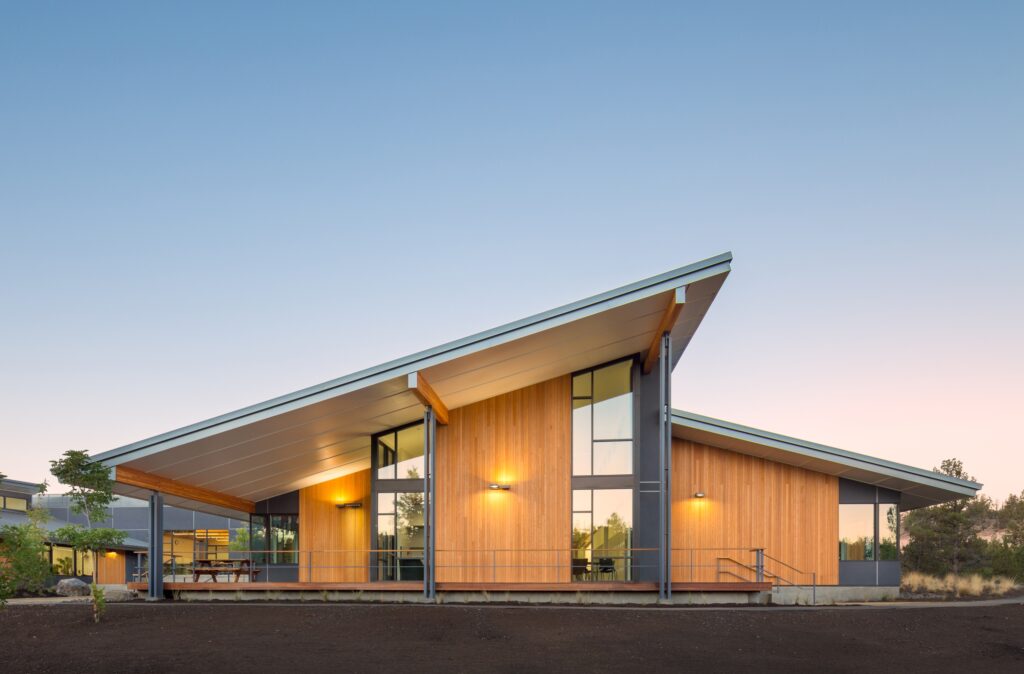
Course Overview Hennebery Eddy Architects will discuss approaches to design featuring wood as a primary material in a range of regional and climatic contexts in the western United States. The session will concentrate on the Cascades Academy of Central Oregon in Bend, OR with discussion of Yellowstone Youth Campus in Yellowstone National Park, currently being designed and the recently completed Seattle Preparatory School Chapel in Seattle, WA. Learning Objectives Wood and wood/steel hybrid structural systems. Architectural design in response to immediate and regional settings and wood siding applications. Versatile interior strategies – structure as finish vs planar design. Building and Site Planning to minimize site disturbance and maximize sustainable design opportunities. Course Video Speaker Bio Timothy R. Eddy, AIA., LEED Accredited Professional Principal Hennebery Eddy Architects Dan Petrescu, AIA. Associate Principal Hennebery Eddy Architects
Plant a Seed Designing with Wood and Bio based Materials

Course Overview Concrete, steel, and aluminum are responsible for 23% of the world’s total CO2 emissions. While a portion of those emissions come from other industries, the biggest sinner is without comparison construction. In this presentation, based on Henning Larsen’s recent publication, ‘Plant a Seed’, Fabia will present an alternative, sharing Henning Larsen cases studies and insights on designing with wood and biobased materials for significantly reduced carbon. Learning Objectives Coming soon Course Video Speaker Bio Fabia Baumann Structural Design Engineer / Timber Expert Henning Larsen – Denmark Fabia is a Structural Design Engineer and Timber Expert at Henning Larsen with both theoretical knowledge about timber from her engineering degree and practical experience from her work as a carpenter. She has a passion for timber construction and understands the potential of wood in developing unique, sustainable projects. Given her experiences, Fabia has extensive knowledge about incorporating wood in construction processes. She supports design teams by integrating wood into many projects like Henning Larsen’s World of Volvo experience center in Gothenburg, Sweden; Marmormolen, one of Denmark’s largest wooden structures; and Fælledby, Copenhagen’s first wooden district, and winner of Fast Company’s 2021 World Changing Ideas Awards. Having co-authored Henning Larsen’s Plant a Seed publication, innovative solutions are always in focus for Fabia, by which she strives to promote wood and biomass as essential materials for building a climate-neutral future.
Overview of the Canadian Mass Timber Technical Guide
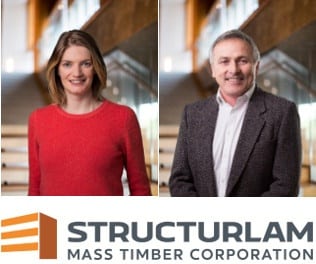
Course Overview Join us for an introduction to a new, comprehensive Canadian technical reference guide to mass timber. Canada’s inherent building-with-wood culture lays a solid foundation for the continued growth of mass timber construction. Learn more about why mass timber is right for your next project, the design process and building systems, code acceptance, our expertise and more. Learning Objectives How mass timber can be incorporated into a variety of structural projects that typically utilize other materials. Design considerations for utilizing mass timber and how the Mass timber guide can provide them with the information to navigate mass timber design. How to use the mass timber reference guide for cross laminated timber and glue laminated timber design and construction. Overview of the economic and sustainable benefits of mass timber construction. Course Video Speaker Bio Orlagh McHugh – BSc, M.Eng, EIT Mass Timber Specialist Structurlam Mass Timber Corporation Vancouver/Vancouver Island, British Columbia, Canada Orlagh McHugh is a Mass Timber Specialist at Structurlam Mass Timber Corporation, overseeing the Lower Mainland and Vancouver Island. Before relocating to BC almost a decade ago, Orlagh earned her Degree in Structural Engineering and Architecture at University College Dublin, Ireland, and went on to complete a Masters of Structural Engineering at the same institution. With over 7 years of experience working with top Vancouver firms as a design engineer, she has contributed to a diverse catalogue of projects across a number of sectors, with a particular focus on wood and mass timber construction. Orlagh is inspired by the innovative nature of mass timber construction and keen to promote creativity, technology and sustainability in our built environment. Ron McDougall Mass Timber Specialist Structurlam Mass Timber Corporation Western/Eastern Canada Ron brings 30 years of heavy timber experience to the mass timber industry that combines a unique perspective on the evolution of hand built timber construction to the technologically advanced practices utilized in Structurlam’s state of the art production process. Ron’s expertise is the facilitation of incorporating BIM practices in pragmatic and meaningful ways to ensure efficient construction of complex mass timber structures.
Sound and Vibration in Mass Timber Buildings: A Practical Guide

Course Overview Following an introductory overview of building acoustics, the presenter will explore both airborne and impact sound transmission in mass timber buildings. While direct sound transmission (i.e., through floor/ceiling assemblies) has been thoroughly tested, indirect sound transmission (i.e., around wall or floor/ceiling assemblies) remains more of a challenge. To address this, the presenter will share findings from recent R&D initiatives aimed at helping maximize exposed mass timber while still adhering to code requirements. This webinar will also examine the sound absorptive properties of mass timber, which play a critical role in environments such as schools, offices, and event spaces. Finally, we’ll conclude with specific design strategies to help prevent late-stage acoustical issues, especially when projects have progressed to a point where certain solutions are no longer feasible. Learning Objectives Gain familiarity with basic acoustic terminology and principles. Understand how sound and vibration can transmit directly and indirectly through the mass timber structure. Discover approaches to addressing sound and vibration transmission through continuous mass timber (CLT) panels. Gain an appreciation of various design considerations affecting the control of noise in mass timber buildings. Course Video Speaker Bio Simon Edwards, M.Eng., P.Eng., ing. Senior Acoustical Engineer, Associate HGC NOISE VIBRATION ACOUSTICS Simon is a member of HGC’s built environment division, with extensive experience in acoustical work across the permitting, design, construction, and post-occupancy phases of residential and commercial buildings. He has worked with poured concrete, hollow-core, wood-frame, and steel-deck structures and has particular expertise in mass timber projects, including Ontario’s first mass timber building, R-Town Vertical 6, and the acclaimed YW Supportive Housing project in Kitchener. Simon’s growing experience in designing and testing various CLT configurations has positioned him as a leader in mass timber acoustics. Simon is also an expert on sound transmission, with a background in both theoretical calculations and experimental sound transmission testing (“Kij Testing”) to evaluate flanking transmission in line with ISO 12354 and ISO 10848. He is a member of both the ISO and ASTM Technical Committees on Building Acoustics and contributes to the development of standards for measurement and calculation methodologies across the industry.
Mass Timber Construction at Canadian Nuclear Laboratories
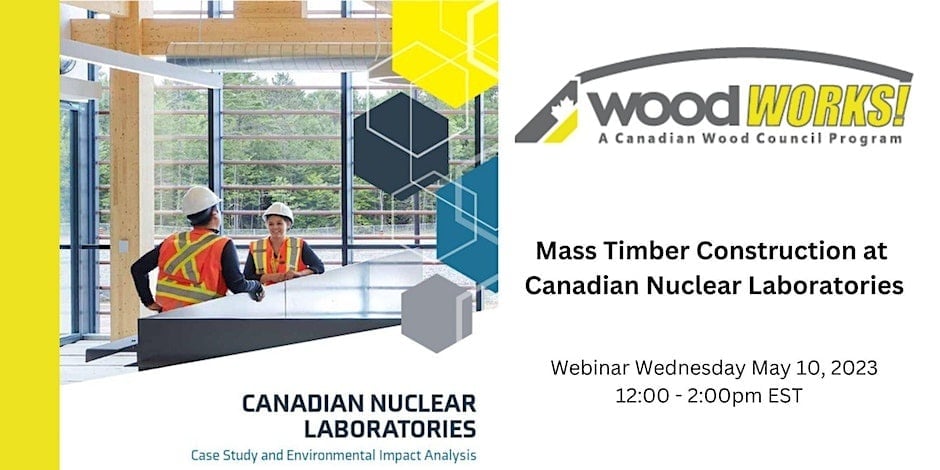
Course Overview Canadian Nuclear Labs’ Chalk River Laboratories comprise the largest single complex in Canada’s science and technology community. The site contains more than 50 unique facilities and laboratories including a three new buildings constructed with mass timber. These three buildings are the focus of a detailed environmental impact study. This webinar will offer a case study of the three buildings and share the results of the environmental impact study. Topics covered by the presentation include:-Why Wood? (drivers that led CNL to chose mass timber)-Carbon Impact (operational, embodied, sequestered, avoided, and a life cycle assessment)-Procurement (Integrated Project Delivery Method)-Building Performance (construction elements, energy performance, envelope performance, fire performance, durability, resiliency, and potential for adaptive reuse)-Code Requirements (regulatory approvals, permit process) The projects are considered successful examples of sustainable procurement aligning with the ‘greening government’ strategy which supports the Government’s commitment to net-zero emissions by 2050, and includes a 40% reduction by 2025 for federal facilities. Learning Objectives Understand the strategic importance of using mass timber construction at CNL and its alignment with sustainability goals, including carbon reduction and the promotion of sustainable building practices. Analyze the logistical and engineering challenges associated with implementing mass timber in a large-scale infrastructure project. Evaluate the benefits of mass timber in the context of operational efficiency, cost-effectiveness, and environmental impact. Discuss the implications of mass timber construction for future building projects in terms of regulatory compliance, market trends, and technological advancements. Course Video Speaker Bio Donald Chong, OAA, MRAIC, B.Arch Design Principal, Associate Vice President HDR Don has firmly established himself in Toronto’s architecture culture through his inventiveness and investment in placemaking. His project skills volley between the strategic planning of urban and institutional work through to the detailing of finely crafted furniture, as well as research-based design. Don has held numerous design conference speaking engagements, from the Wood at Work Conference to the Architectural League of New York, and has been featured in print publications, such as Design Lines, related to mass timber design. Susan Croswell, OAA, MRAIC Project Delivery Principal HDR Susan is a project architect with over 27 years of diversified experience. Her expertise in both architectural design and technology allows her to excel in the profession from concept design through to contract administration. Susan’s ability to deliver complex projects and documentation on time is a hallmark of her work and is achieved through effective leadership and teamwork. She has developed a reputation as a highly competent, efficient, effective and approachable project architect who loves the challenges that each and every project brings to the team. Some of her recent, award-winning projects include the CNL Chalk River Laboratories “New Builds,” Queen’s University John Deutsch University Centre, and Kingston Frontenac Public Library. Ryan Zizzo, PEng, MASc, LEED AP ND Founder & CEO Mantle Developments Ryan Zizzo is a professional engineer and Founder & CEO at Mantle Developments, a consultancy focused on climate-smart infrastructure and buildings, based in Toronto. Mantle helps projects go beyond energy efficiency, incorporating resilience, embodied carbon emissions, and life cycle approaches to make projects future-proof and net-zero carbon ready. Ryan is a recognized leader in helping large organizations and governments transition to a low-carbon future. He has directly supported the Government of Canada, several provincial Ministries, the City of Toronto, the YMCA of Greater Toronto, and numerous developers, property managers, and real estate investors.
Joining Tradition and Innovation with Mass timber Connections

Course Overview An overview of traditional, state of the art and innovative wood fasteners and connectors. This course is of particular interest to structural engineers and design professionals interested in structural engineering. Learning Objectives Wood Properties and their influence on timber connection design. Overview of traditional, state-of-the-art and innovative fasteners and connectors. Ductility and durability aspects in connection with dowel type fasteners. Modern carpentry – a resurrection of traditional framing through CNC. Best practices for the design of mass timber connections. Course Video Speaker Bio Patrick Geers Senior Structural Designer, Head of Quality Control Western Archrib As the company’s senior engineering designer Patrick is in charge of the design of structural wood systems including fabricated steel connections and hardware He is involved in the development and presentation of building proposals to support sales efforts and cooperates with the production team to develop manufacturing solutions In addition, he is responsible for the supervision of quality control department Patrick has over 17 years experience in the glulam industry an currently sits on CSA 086 Sub-committee.
Inspired Design

Course Overview This presentation explores the art and science of inspired structural design, emphasizing how engineering can harmonize beauty, efficiency, and sustainability. By allowing the structure itself to help inform the concept, it is possible to craft designs that are not only innovative but also deeply connected to their environment. This session will delve into strategies for designing sustainably, focusing on the most structurally efficient use of materials to reduce waste and environmental impact. Through case studies and examples, the presentation highlights how thoughtful engineering creates beautiful structures that people love to own and use. Attendees will leave with actionable insights into achieving designs that inspire and perform. Learning Objectives Inspired design does not need to cost more, it is often more economical. Design-Build is the perfect delivery method for true Inspired Design. Inspired design requires a cohesive design team from the start. Collaboration of project constraints is key to Inspired Design. Course Video Speaker Bio Aaron Schroeder Business Development Engineer StructureCraft Aaron graduated from the University of British Columbia with a bachelor’s degree in civil engineering and began his career as a structural engineer in the residential construction industry, earning his P.Eng. designation in 2018. His project portfolio spans heavy civil concrete structures, high-end single-family homes, and multi-family residential complexes. Since Joining the StructureCraft Team in 2021, Aaron served as the project engineer for the 7-story T3 office building in Nashville, Tennessee, before transitioning to the Business Development team. With a strong foundation as a structural engineering consultant, construction contracting experience, and a personable/outgoing demeanor, Aaron is passionate about fostering meaningful connections within the AEC industry. As one of the primary points of contact for new project inquiries, he plays a key role in introducing clients to StructureCraft’s innovative approach.
Harnessing Prefabrication: How to Navigate the Design and Construction Process
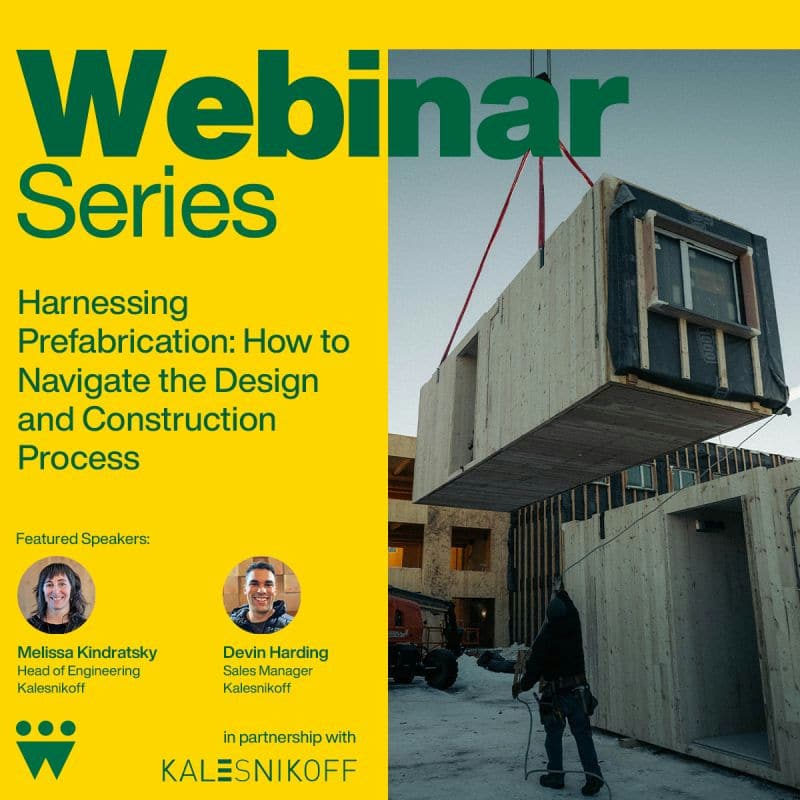
Course Overview This course offers an in-depth discussion on the evolving landscape of modular and prefabricated construction. The course will explore how to evaluate and integrate different levels of prefabrication based on project goals, site conditions, and logistical constraints. Key topics include site planning, design coordination, transportation logistics, and navigating regulatory requirements. We’ll also delve into technical considerations—comparing mass timber and drywall fire ratings, evaluating STC performance, and planning for MEP sub-module integration. The session will conclude with strategies for structural design of modular systems and insights on avoiding common post-construction pitfalls. Grounded in lessons learned from a completed multi-family volumetric modular CLT project, this presentation offers practical tools for design professionals, engineers, and developers looking to optimize prefabrication in their projects. Learning Objectives Understand key decision-making criteria for selecting appropriate prefabrication strategies. Apply a framework for integrating prefabrication into project planning and delivery. Recognize technical challenges and solutions in modular design, including fire ratings, acoustics, and MEP coordination. Identify best practices for optimizing structural integration and avoiding post-construction issues. Course Video Speaker Bio Melissa Kindratsky Head of Engineering Kalesnikoff Devin Harding Sales Manager Kalesnikoff
Diversify Your Structural Portfolio: Wood in Low-Rise Commercial Construction
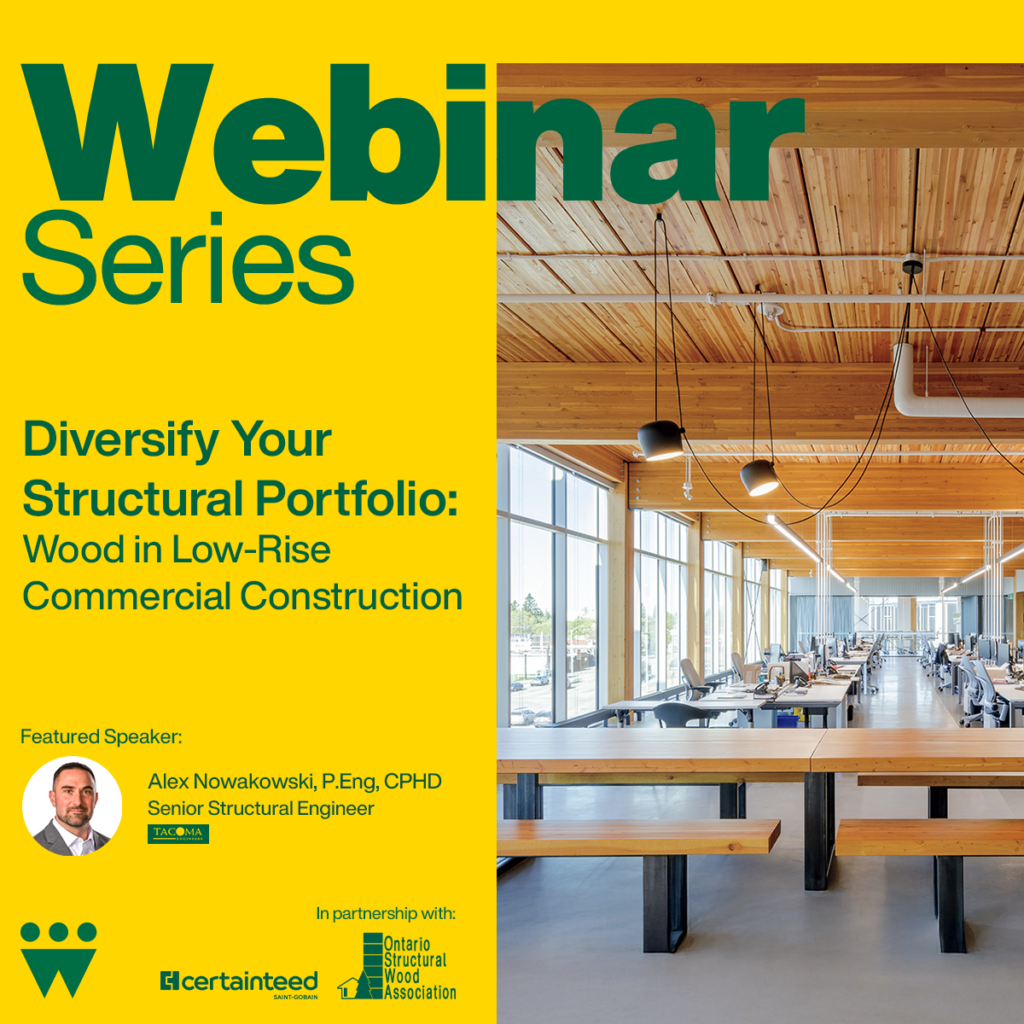
Course Overview This course will explore the use cases for incorporating more wood into a sector that is typically dominated by structural steel construction. We will look at Light Wood Framing (LWF), Structural Composite Lumber (SCL), Mass Timber (MT), and Hybrid Systems that may incorporate any or all of these materials, as well as structural steel. What is important is using the right material in the right application. Several examples from the CWC Publication “Low-Rise Commercial Construction in Wood: A guide for Architects and Engineers”, as well as real project examples from the presenter. Learning Objectives Identify strengths and weaknesses of various wood products. Learn to select the right wood material/system for the most efficient and cost effective structure. Highlight critical details and identify potential red flags to ensure a successful project. Provide useful examples, resources and tools for the practitioner to add to their “tool belt”. Course Video Speaker Bio Alex Nowakowksi Engineer, Senior Associate, and Barrie Team Lead Tacoma Engineers Alex is a Professional Engineer, Senior Associate, and Barrie Team Lead for Tacoma Engineers. Alex has been with Tacoma Engineers since 2012. As a Senior Structural Engineer and Project Manager, Alex has been the Primary Structural Engineer and Specialty Structural Engineer on a wide variety of wood projects in the Commercial, Institutional, Multi-Family, Agricultural and Residential Sectors.
Design Options for Three and Four Storey Wood School Buildings in British Columbia
Course Overview There are currently a number of planned new school projects throughout British Columbia that require either three ‐ or four‐storey buildings, and this demand is increasing as land values continue to rise. Though timber construction offers a viable option for these buildings, code constraints have limited timber schools to a maximum of two storeys while also imposing overall floor area limitations. Consequently, the development of viable structural options for larger timber school buildings has lagged. This session will explore the range of possible timber construction approaches for school buildings up to four storeys in height within a seismic region. Learning Objectives 21st century school planning principles and their impact on timber building construction. Timber vertical load‐bearing systems with a focus on the technical considerations and architectural implications related to school buildings. Timber lateral force‐resisting systems with a focus on the technical considerations and architectural implications related to school buildings. Comparison of a few possible design concepts for four‐storey timber school buildings. Course Video Speaker Bio Nick Bevilacqua Associate Principal Fast + Epp With 15 years of industry experience, Nick has a broad experience base that enables him to be fluent in all building types and primary structural materials. Nick has considerable experience in the education sector, and is currently working on a number of schools throughout the province that feature various configurations and degrees of timber construction. Ray Wolfe Partner Thinkspace Architecture Planning and Interior Design Ray is an architect and partner at Thinkspace Architecture Planning and Interior Design. He is an award‐winning architect with a focus on institutional and specifically education projects. As a practicing architect, Ray has been involved in advancing the knowledge of topics such as modular construction, school area standards and a variety of studies involving the use of wood in schools with the Ministry of Education, FII and Wood WORKS!. Ray believes passive sustainable strategies and the use of wood play an important role in the next generation of education buildings in Canada.
Benefits of Building with Mass Timber

Course Overview Building with mass-timber elements affords a contractor many benefits including quality, accuracy and time. But contractors are often unaware of these benefits until immersed in a new project. With the conversion experience had by Willmott Dixon the company advanced its skills has served to inform their clients and the designers with whom they work. Learning Objectives How a large construction company – transitioned to include mass timber projects in its portfolio. How to evaluate key business considerations — cost, time, environment. How building with mass timber can change the construction planning process — engaging with design teams and clients. How mass-timber projects came to fruition. Course Video Speaker Bio Duncan Purvis With nearly a quarter of a century of experience in the construction industry in operational, commercial, sales, bid writing, marketing and most aspects of the delivery of complex construction projects and offers a 100% customer journey that is built on true trust. With many construction projects from Four Seasons Miami, Natural History Museum London, Pfizer’s European headquarters and many more high-prestige projects. Duncan is proudest of the Multiple Schools projects, that with his Structured Timber Solution, are providing high quality teaching environments that are not only fully sustainable and highly efficient, but also work out as some of the most economical teaching spaces available in Europe.



